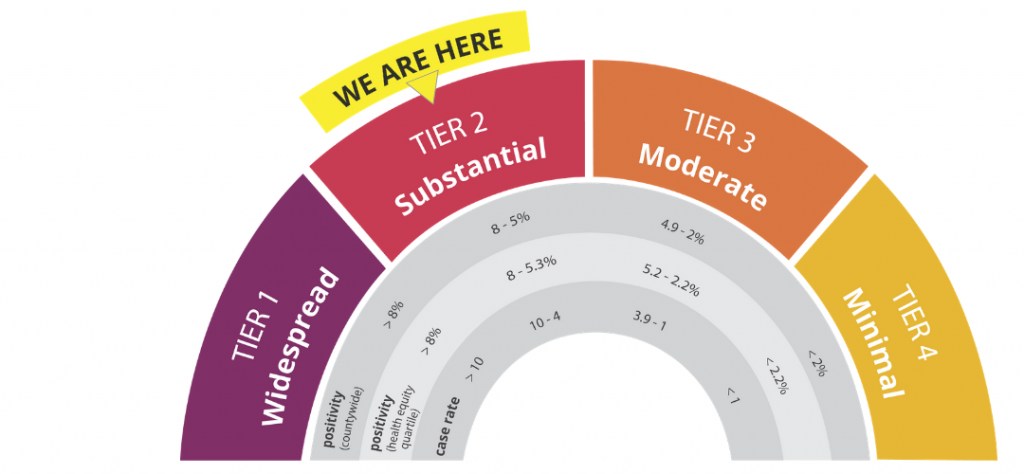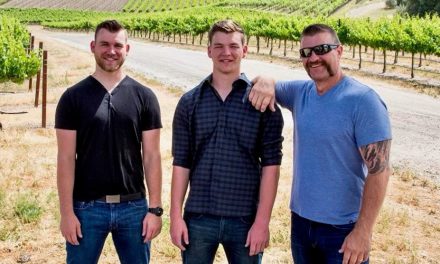State passes an incentive package to accelerate the safe return to in-person instruction
SAN LUIS OBISPO COUNTY — In March, San Luis Obispo County moved from the Purple Tier to the Red Tier of the state’s “Blueprint for a Safer Economy.” With hopes to move to the Orange Tier in the next few weeks.
The State’s Blueprint allows for counties in the Red Tier to reopen a degree of indoor operations and resume certain activities. To reopen local businesses, they must follow all State guidance for their industry and self-certify that they are ready to reopen safely.
“This is a positive step in the right direction for our community, and I’m happy that we’re able to reopen more parts of our community,” Dr. Penny Borenstein, San Luis Obispo County Health Officer, explained in a released statement. “But we cannot take this gift for granted. We must remain vigilant as we move forward so that we do not undo this good work.”
This news comes almost a year after the nation declared a State of Emergency on Mar. 13, 2020, which enabled FEMA to operate as a vehicle to deliver virus response funds to state and local governments.
Governor Gavin Newsom signed an executive order on Mar. 4, 2020, proclaiming a State of Emergency to exist in California as a result of the threat of COVID-19, where he stated that in a short period of time, COVID-19 had rapidly spread throughout California, necessitating updated and more stringent guidance from federal, state, and local public health officials.
Newsom explained that the preservation of public health and safety throughout the entire State of California would be necessary for all Californians to heed the State public health directives from the Department of Public Health and help “flatten the curve” by sheltering-in-place for 15 days.
As time shows that 15 days changed the world as we knew it forever.
After a long summer, Governor Newsom unveiled the “Blueprint for a Safer Economy” in August 2020. This was a statewide, stringent, and slow plan for living with COVID-19.
According to the documents, the plan-imposed risk-based criteria on tightening and loosening COVID-19 allowable activities and expanded the length of time between changes to assess how any movement affected the disease’s trajectory.

This plan introduced the four colored tiers – Purple (Widespread), Red (Substantial), Orange (Moderate), and Yellow (Minimal) – based on how prevalent COVID-19 is in each county and the extent of community spread. That color would indicate how sectors can operate.
The plan also included an “emergency brake” where the state could intervene more immediately for concerning factors like hospitalizations. It also emphasized that no matter what restrictions the state put in place, COVID-19 would get the upper hand if Californians did not adapt their behaviors for the duration of the pandemic, however long that would be.
Once the state announced the change in tier status on Mar. 3, almost a year after the pandemic began, it meant that many businesses could resume modified indoor operations and activities. Some of those businesses included restaurant dining, movie theaters, and museums, all deeply impacted financially by the pandemic.
During this time, the state and county were steadily administering the allotted COVID-19 vaccinations at the dedicated clinics. On Mar. 8, the Centers for Disease Control (CDC) issued the first set of guidelines on how fully vaccinated people can visit safely with others; the county shortly after followed suit.
“While we are excited to offer this new guidance to the community, we urge all SLO County residents, including those who are fully vaccinated, to continue taking health precautions in public,” said Dr. Penny Borenstein, County Health Officer. “Please continue to wear a mask in public, get tested if you’ve been exposed, and avoid large gatherings.”
The news came directly after SLO County announced that it had received its first allocation of the Johnson and Johnson single-dose COVID-19 vaccine, which received its Emergency Use Authorization (EAU) from the Food and Drug Administration.
The single-dose COVID-19 vaccine was developed by the Janssen Pharmaceutical Companies of Johnson and Johnson. It is the third COVID-19 vaccine available in the United States and has been through rigorous testing over the last year as a result of “Operation Warp Speed.”
“Operation Warp Speed” was created as a response to Former President Donald Trump’s call last year to develop 300 million doses of the SARS-CoV-2 vaccine by January 2021. According to reports, the U.S. Department of Health and Human Services (HHS) and AstraZeneca collaborated to make available at least 300 million doses of a coronavirus vaccine by last October.
“The COVID-19 vaccine by Johnson and Johnson is very effective at preventing severe disease, hospitalization, and death from COVID-19,” said Dr. Penny Borenstein, County Health Officer. “Adding a third safe and effective vaccine to our arsenal will be instrumental in the fight against COVID-19. This is great news for our community.”
Following this, Governor Newsom announced that since the state began dedicating 10 percent of vaccine supply for education workers on Mar. 1, over 200,000 education workers have been vaccinated, far exceeding the state’s goal of 75,000 vaccines per week.
“This is welcome news for teachers, students, and parents as more and more schools reopen safely across the state,” said Governor Newsom. “We will continue working with our local partners to accelerate this effort in communities across the state so that all school staff have access to a vaccine within weeks.”
The week prior, on Feb. 24, all organized youth and adult sports with modifications were allowed to resume in San Luis Obispo County with some modifications based on guidance from the California Public Health Department.
“Youth sports are important to our children’s physical and mental health, and our public health approach has worked to balance those benefits against COVID-19 risks,” said Aragón. “With case rates and hospitalizations declining across California, we are allowing outdoor competition to resume, with modifications and steps to reduce risk, in counties where case rates are lower.”
Then a week later, on Mar. 4, the California group “Let Them Play CA,” who fought to bring back high school and youth sports, announced a settlement agreement with the State of California that would allow for the return of all sports in the state with specific guidelines.
“We have reached a settlement with the State of California on our lawsuit,” Scripps Ranch High School coach Marlon Gardinera said in the press conference. “The terms of the temporary restraining order here in San Diego allowing all student-athletes to return to play both indoor and outdoor will now go into effect statewide. All high school sports can begin in California.”
On Mar. 6, Newsom signed a $6.6 billion package to accelerate the safe return to in-person instruction across California and empower schools to immediately expand academic mental health and social-emotional supports, including over the summer.
Immediately following, each school district in San Luis Obispo County released a plan of action to get kids back in school at all ages. Most High Schoolers were able to finally return to campus for the first time since March 2020 and are following a hybrid model, which means a portion of time on campus and virtual for the time being.
Even though the community is still in the midst of navigating its way through the pandemic and an average day at work or school looks very different for everyone right now, it is definitely a step in a positive direction one year later.







